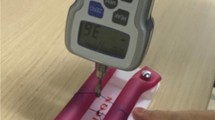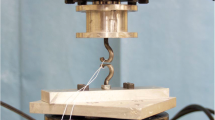Abstract
Background
The widespread availability of adult minimal access surgical (MAS) equipment together with resource constraints have led pediatric surgeons to adopt the adult setup. This study examined the influence of instrument size on task outcome and physical impact on the surgeon in pediatric endoscopic intracorporeal knot tying.
Methods
Sixteen surgeons participated in this study in which they had to tie surgeon’s knots inside a neonatal simulator box with an endoscopic field of 40 mm. All surgeons tied 20 knots using paired pediatric needle-holders and 20 knots using paired adult needle-holders in a randomized order. Knot quality score (KQS) and wrap length were used as indices of knot quality and wrap tightness. Electromyographic (EMG) recordings of the upper limb muscle groups were used to indicate muscular recruitment. A questionnaire on discomfort and instrument preference was also completed by the surgeons.
Results
A total of 640 knots were analyzed. Median time was shorter for pediatric needle-holders than for adult needle-holders (94 s vs. 103 s; p < 0.001); however, KQS (0.271 vs. 0.260; p = 0.509) and the tightness around the tube (86 mm vs. 86 mm; p = 0.255) were not significantly different. The proportion of knots that completely slipped was also similar for both needle-holders (19% vs. 22%; p = 0.322). The normalized EMG values when using adult needle-holders were significantly higher than when using pediatric needle-holders in all upper limb muscle groups with the exception of left forearm extensors (p = 0.460). The surgeons reported less discomfort with the pediatric needle-holders in the right forearm and hand, and 13 surgeons expressed overall preference for the smaller instruments.
Conclusion
Endoscopic knot tying was performed faster in the neonatal simulator box using pediatric needle-holders while maintaining knot quality. Upper limb muscular recruitment was reduced resulting in less discomfort for the surgeon.


Similar content being viewed by others
References
Berguer R, Forkey DL, Smith WD (1999) Ergonomic problems associated with laparoscopic surgery. Surg Endosc 13: 466–468
Cuschieri A (1995) Whither minimal access surgery: tribulations and expectations. Am J Surg 169: 9–19
Berguer R, Rab GT, Abu-Ghaida H, Alarcon A, Chung J (1997) A comparison of surgeons’ posture during laparoscopic and open surgical procedures. Surg Endosc 11: 139–142
Holcomb GW III, Rothenberg SS, Bax KM, Martinez-Ferro M, Albanese CT, Ostlie DJ, van der Zee D, Yeung CK (2005) Thoracoscopic repair of esophageal atresia and tracheoesophageal fistula: a multi-institutional analysis. Ann Surg 242: 422–428
Rothenberg SS (2002) Laparoscopic duodenoduodenostomy for duodenal obstruction in infants and children. J Pediatr Surg 37: 1088–1089
Martinez-Ferro M, Esteves E, Laje P (2005) Laparoscopic treatment of biliary atresia and choledochal cyst. Semin Pediatr Surg 14: 206–215
Rothenberg SS, Chang JH, Bealer JF (1998) Experience with minimally invasive surgery in infants. Am J Surg 176: 654–658
Vereczkel A, Bubb H, Feussner H (2003) Laparoscopic surgery and ergonomics: it’s time to think of ourselves as well. Surg Endosc 17: 1680–1682
Hanna GB, Cuschieri A (1999) Influence of the optical axis-to-target view angle on endoscopic task performance. Surg Endosc 13: 371–375
Hanna GB, Shimi S, Cuschieri A (1997) Influence of direction of view, target-to-endoscope distance and manipulation angle on endoscopic knot tying. Br J Surg 84: 1460–1464
Hanna GB, Shimi S, Cuschieri A (1997) Optimal port locations for endoscopic intracorporeal knotting. Surg Endosc 11: 397-401
Hanna GB, Shimi SM, Cuschieri A (1998) Task performance in endoscopic surgery is influenced by location of the image display. Ann Surg 227: 481-484
Berquer R, Smith WD, Davis S (2002) An ergonomic study of the optimum operating table height for laparoscopic surgery. Surg Endosc 16: 416–421
Hanna GB, Frank TG, Cuschieri A (1997) Objective assessment of endoscopic knot quality. Am J Surg 174: 410–413
Kamen G, Caldwell GE (1996) Physiology and interpretation of the electromyogram. J Clin Neurophysiol 13: 366–384
De Luca CJ (1997) The use of surface electromyography in biomechanics. J Appl Biomech 13: 135–163
Burden A, Bartlett R (1999) Normalisation of EMG amplitude: an evaluation and comparison of old and new methods. Med Eng Phys 21: 247–257
Yang JF, Winter DA (1984) Electromyographic amplitude normalization methods: improving their sensitivity as diagnostic tools in gait analysis. Arch Phys Med Rehabil 65: 517–521
Emam TA, Hanna GB, Kimber C, Dunkley P, Cuschieri A (2000) Effect of intracorporeal-extracorporeal instrument length ratio on endoscopic task performance and surgeon movements. Arch Surg 135: 62–65
Acknowledgment
The authors thank Karl Storz GmbH & Co. KG and the University of London Central Research Fund for equipment sponsorship.
Author information
Authors and Affiliations
Corresponding author
Additional information
Presented at the 10th World Congress of Endoscopic Surgery incorporating the 14th International Congress of the European Association for Endoscopic Surgery (EAES), Berlin, Germany, 13-16 September 2006
Preliminary data of this study were presented at the British Association of Paediatric Surgeons Annual Conference, Stockholm, Sweden, 20 July 2006
Rights and permissions
About this article
Cite this article
Lee, A.C.H., Haddad, M.J. & Hanna, G.B. Influence of instrument size on endoscopic task performance in pediatric intracorporeal knot tying. Surg Endosc 21, 2086–2090 (2007). https://doi.org/10.1007/s00464-007-9311-z
Received:
Revised:
Accepted:
Published:
Issue Date:
DOI: https://doi.org/10.1007/s00464-007-9311-z




